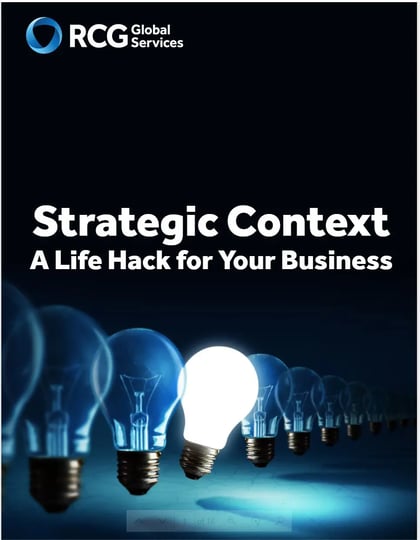Strategic Context: A Life Hack for Your Business
Why is it so difficult to incorporate strategic direction downstream into business culture?
Strategic Context

Ultimately, this lack of “strategic awareness” is counter-productive and keeps your business from achieving its long-term strategic goals.
In the quest to continually simplify and optimize processes, businesses have managed to eliminate the most valuable aspect of workforce enablement, which ultimately impacts customer engagement and satisfaction.
Today, technology has been marshaled to monitor and track the performance of just about every aspect of the business. Product movement, information flow, and customer service throughput are all tuned to optimize profits while enhancing customer experience, enriching employee engagement, and minimizing non-value-added tasks. Human productivity, when not replaced by automation, has been pushed to new levels. All of this happens while the average employee is less aware of the business strategy and how their activities and decisions directly impact the strategy of the company or the key business targets.
The Problem – Strategic Awareness

At the same time, expectations for personalized customer engagement, effective workforce enablement, and optimized operations are increasing. Most organizations have experienced success in addressing some areas of the problem, but usually not all or not consistently. Workforces are stretched, and many remain unaware or insufficiently aware of the company’s intended strategies and goals. Ironically, it is these same individuals that are expected to implement those strategies and collectively achieve the goals.
In recent years, much time and effort have been invested in simplifying or automating business processes. Advancements in analytics and new automation tools have transformed many aspects of business today; however, the promise of robotic process automation (RPA) and artificial intelligence (AI) has not yet eliminated the need for skilled information workers to assess, decide, and act according to established business processes and complex workflows.
Additionally, they often execute these processes without a clear understanding of the larger strategic aims of the organization or even how their individual decisions and actions contribute to the company’s key strategic goals. In many cases, the average team member does not clearly understand the company’s current strategy and cannot keep pace with frequently changing priorities. This lack of “strategic awareness” is often at the core of operational and organizational dysfunction. It can directly lead to counter-productive efforts and acceleration of wasted time on non-value-added activities.
Why is it so difficult to incorporate the strategic direction into the business culture?

- An overwhelming strategic plan: Managers don’t know where to begin. The goals and initiatives generated in the strategic planning process are too numerous because the leadership team failed to make the tough choices to eliminate non-critical actions.
- Unrealistic goals: While strategic objectives may stretch the organization, they still must be realistic. If people feel the goals are unachievable, they may not try.
- Lack of leadership: This issue is at multiple levels. It is not only about ensuring that each manager at each level is clear about the accountabilities and authorities they have for strategy implementation; it is about all managers understanding their role as a people manager.
- Focus on structural changes: Many organizations overly rely on structural change to execute strategy. While changing structure has its place, it is only one part of the requirement for successful strategy implementation.
- Unclear accountability: If people are not clear of their role and their accountabilities for strategy delivery, or are not held accountable for their work, it’ll be business as usual for all but a few frustrated individuals. Clear accountability helps drive change.
- Lack of empowerment: Accountability needs matching authority to deliver outcomes. It also needs the tools and resources necessary to achieve strategic initiatives.
- Lack of communication: Communication helps with organizational alignment. If a plan doesn’t get communicated to employees, they won’t understand their role or how they contribute to achieving the organization’s strategy.
- Getting caught up in the day-to-day: Managers are often consumed by daily operational problems and lose sight of long-term goals. Unless there is an organizational focus on strategy implementation, managers will focus on their day-to-day work.
- Lack of clarity on actions required: The actions required to execute the strategy are not specified or clearly defined.
- Inadequate monitoring: Managers are unable to assess if the strategy is being achieved. Without clear information on how and why performance is falling short, it is virtually impossible to take appropriate action.
- No progress reporting: There’s no method to track progress, or the plan only measures what’s easy, not what’s important, so no one feels any forward momentum.
- Lack of alignment: The organization has not been aligned for strategy implementation. Organizational silos and culture blocks execution and/or organizational processes don’t support strategic requirements.
How to address strategy implementation challenges?

Although these are critical components for strategy implementation and need attention, they usually do not address the challenges of strategic awareness at the action or decision-making level. A quick fix or easy practice is needed to ensure that this strategic awareness is impacting actual operational decisions.
A potential approach
With the ubiquity of social media in today’s society, there has been a surge of individuals sharing simple tricks on how to address complex problems faced in everyday life. These guides are affectionately known as “life hacks” that promise to improve your working or personal life.
Today you can find a life hack for virtually every aspect of life:
- Home & Auto Maintenance
- Food Storage & Preparation
- Time and Money Saving
- Technology Uses
- Education & Learning
- Health & Fitness
- Personal Productivity
The basis of a “life hack” is a simple or clever solution to a frustrating or complex problem.
Life hacks in the workplace
The term “life hack” was originally coined in 2004 at an O’Reilly Emerging Technology Conference by journalist Danny O’Brien in reference to shortcuts used to get work done or avoid tedious tasks.
The best [life hacks] involve tricks that are free, efficient and stunningly obvious in retrospect, deploying everyday items for purposes beyond their wildest aspirations. – Michael Koziol
In the work context, some examples of life hacks are:
Always type in the address last

Make sure you don’t accidentally hit send before you’ve had a chance to look it over. Make the address line the very last thing you type in. That way, you always know you’re sending out a perfect, proofread product. No accidents! You can also set up (in Gmail based clients, anyway) a 5-10 second send delay, which gives you the chance to “undo” when you’ve sent too soon.
Source: 8 Convenient Life Hacks for the Workplace, Peter Jones1
Finish meetings with 3 questions
- What do we need to do now?
- Who’s going to do it?
- What’s the deadline for this task?
Answering these three questions means your meeting has been summarized, and the takeaways are clear. There’s nothing worse than leaving a meeting feeling like you’ve got nowhere. Answering these three questions means you will keep moving.
Source: 10 Life Hacks for Making Recruiting Life Easier, Ruby Lowe2
Establish a strong company culture
Want your business to really stand out? Create traditions and build a story around your company. A successful company culture makes employees feel like part of the team and focus their skills on improving the business. Be it free lunch every Friday or collective vacations, a standout company culture makes talent and renown come your way.
Source: Business hacks: 10 Lifehacks Applied to Business3
Given the complexity of today’s work environment, it is no wonder that more people are looking to shortcuts and simple techniques to stay productive and reduce stress levels.
Life hacks are effective because they are:
- Simple to understand
- Easy to execute
- Easy to remember
(And most importantly) - They work
By applying this “life hack” concept to the challenge of strategic awareness in business decisions, we supplement the core principles (Simplify the Strategy, Enhance the Communication, and Empower Resources) by providing a missing component that seeks to simplify how we put strategy into action.
Life Hacks for your Business

#1 – Evaluate basic decisions in the context of the strategy or goal
Every day an average business makes thousands of decisions – from major decisions like capital investments to smaller, yet often more impactful, decisions like how to react to an unhappy customer. As consultants, RCG sees organizations striving to make better, data-driven decisions. They attempt to create complex decision matrices or apply data science techniques to various business problems to learn the impacts of previous decisions. Analytics may provide the logical answer or next step, but often the data or algorithm is not addressing the full strategic context.
Strategic context needs to be at the core of business decisions and consideration in all supporting analytics and decision models. A great data-driven organization that does not incorporate strategy considerations will not achieve long-term business goals. The bottom line is to keep this context in mind wherever and whenever possible, always to ensure alignment of direction.
Examples of Addressing the Challenges of Strategic Context
Personalized Customer Engagement – While a team member is interacting with a customer about potential purchase options, what recommendation should be made? How are these options prioritized, emphasized or rationalized? Clearly, the customer is looking for good advice that is personalized to their specific needs. If there are multiple options that fit the specific needs of the customer, which should the team member highlight?
The first option should put this situation in the context of the organization’s strategic goals. If customer retention through superior customer service experiences is a key corporate strategy, then the best strategic approach requires an option that will meet each customer’s need for personalization and is likely unique – a non-obvious, non-standard solution that satisfies the goal of superior customer service. Achieving a strategic context should change the calculus of the action where possible.
Effective Workforce Enablement – While a shift lead at a healthcare provider is weighing potential staff scheduling options, what key factors should be considered? Is overtime minimization, optimized utilization, and employee preferences the driving factors? Is there a strategic implication to this problem as well?
If the company determines that employee engagement through diverse work experiences is a key long-term strategic benefit, then scheduling should consider minimizing regularity of assignments and providing cross-training to new areas.
Strategic awareness is not going to happen organically; we need to systematically take a few extra moments to think strategically.
#2 – Inject strategy & goals directly into current processes
Another way to force strategic awareness into your business is to directly “inject” it into your processes. Applications are key components in today’s processes that ensure we have efficient operations. Applications are developed to speed up the processing of inputs, enforce business rules, automate decisions, and deliver results to users to influence their actions. Application logic reflects the current understanding of typical use cases where inputs and expected outputs are known. Beyond the applications, analytics seeks to uncover additional insights or address many “what-if” scenarios. Business decisions rely on these capabilities to guide actions.
In data science, it is good practice to eliminate any inputs (features) that do not directly impact the results. Feature analysis distills the key question down to the elements that drive the result. Unfortunately, strategic weighting factors are rarely ever included as inputs to these models. Likewise, with application development, developers create solutions that efficiently take the minimal number of inputs and process them using the minimal amount of code to achieve a result set that can be consumed by the user. The presentation of results are designed to be simple to understand with little amount of ancillary information. Strategic considerations need to play a larger role in application development. When creating or enhancing the analytics and applications that are utilized to execute current business processes, add in the strategic factors to impact the weighting of results or action recommendations.
#3 – Communicate evolving strategies with new stories or examples
Most corporate strategies are thoughtful yet abstract. They usually require some interpretation between intentions and the resulting actions. Keep your strategy relevant by providing examples where team members applied strategic principles in everyday operations. Relatable stories provide the primer for others to deepen their understanding and appreciation for the intent and function of the strategy. When designing strategies, it is common to consider how daily processes are being executed and to assess the resulting outcomes. It is logical to reverse this thought process when communicating examples of applying the strategy to daily processes.
Storytelling is a proven method for effective communication. A business strategy, and especially the best approach to apply that strategy, does not tend to be naturally intuitive.
It seems that we can conclusively say that the human mind is able to relate to and absorb stories much better if there is a “human” element in the story that is easy for the audience to imagine. – Gregory Ciotti, Sparring Mind
If business success depends on strategy, then ensuring the easy consumption of that strategy should be a primary concern. Take the time to communicate real-world, relatable stories of where strategy was considered and drove positive outcomes as intended. Life hacks are simple and memorable – using this life hack will make your strategy memorable as well.
RCG's Approach

RCG’s Approach to: Simplify the Strategy
Decisions about opportunity priorities, initiative execution, and outcome measurement are all based on a core set of Strategic Drivers that derive directly from the goals and strategy of the organization.
Strategic Drivers are identified, refined, socialized, and aligned before any initiative or action is recommended or undertaken. The intended application of the strategy is clarified by additional analysis of the drivers.
RCG’s Approach to: Enhance Communication
Communicating the strategy depends on understanding how the strategy will be implemented. This is often difficult because a comprehensive strategy requires coordinated activities across groups. RCG utilizes a roadmap and initiatives map to aid in communication of strategy and its implementation to the larger organization. The roadmap is then built upon the underlying strategic direction, so each action has strategic context.
RCG’s Approach to: Empower Resources
Empowering resources relies on an accurate understanding of capabilities across people, process, and technology. RCG identifies key capabilities that need attention and includes the solution in the overall strategic approach.
Monitoring progress against strategy and goals enables resources to visualize how targets are being achieved. Regular analysis and reporting provides a culture of strategic awareness and alignment.
It is easy to get caught up in the big issues of the day and not act on small opportunities to make modest positive changes. Take a few minutes to consider how to engage these simple life hacks. Keep an eye out for other simple strategy awareness-building techniques that can become new life hacks for your business. Reinforce your strategic intent by directly building in strategy context and consideration into your existing technology, process, and culture.
Transformation is a journey, and attempting to change culture requires various tools and techniques. A successful strategy cannot be left to leadership to appreciate; it must be intentionally injected into the business operations and day-to-day decision made by all.
A final note about Strategy Awareness in the year of coronavirus:
The current COVID-19 outbreak and its impacts on business operations illustrate the immense complexities in conducting business activity without clarity around future economic impacts, workforce availability, remote workforce efficiencies, changing state and local health decisions, or required changes in customer behavior. Current business processes were not designed with these challenges in mind. Team members will need to make very different decisions based on completely new pieces of information and external constraints. Most businesses would hope that these decisions are still aligned with the overall strategic directions set out for the business. Alternatively, this may be a time where the strategies of many companies need to change. Companies need to have more adaptable processes to handle when customers can’t interact as they did yesterday, teams can’t work like they have previously, and new services and capabilities to maintain operations need to be quickly implemented to address new constraints.
Works Cited
1. The Job Network. Retrieved from https://community.thejobnetwork.com/8-convenient-life-hacks-for-the-workplace/
2. Undercover Recruiter. Retrieved from https://theundercoverrecruiter.com/life-hacks-work/
3. Scoro. Retrieved from https://www.scoro.com/blog/business-hacks-part-1/
Download a PDF version of this ebook by filling out this form


